Xerophytic Shrubs That’ll Still Flourish in Your Dry Yard
The prefix ‘xero-‘ means dry, indicating that most xerophytic shrubs live in arid areas. These plants have become accustomed to dry conditions by either storing water in their foliage or preventing water loss in some way. All of the following examples of xerophytic shrubs are plants that can grow in dry conditions and survive during time periods or in desert like regions.
9 xerophytic shrubs for Your Landscape
![]() Bee Brush (Aloysia gratissima)
Bee Brush (Aloysia gratissima)
Native to South America and the Chihuahua Desert, the semi-evergreen bee brush stands six feet tall and wide and prefers full sunlight exposure. Medium-green leaves and small thorns provide a backdrop against white to light purple flowers in the spring, summer and fall. Both the foliage and flowers of this moderately growing shrub are fragrant.
![]() Creosote Bush (Larrea tridentata)
Creosote Bush (Larrea tridentata)
The creosote bush can survive for two years without water, making it the most drought tolerant perennial plant in North America. It can live for that long due to the shedding of its evergreen leaves; it’ll sometimes even shed its branches. The small, thick, green leaves turn to a golden-brown color during seasonal drought.

Flattop Buckwheat (Eriogonum fasciculatum v. polifolium)
The fast-growing flattop buckwheat only measures a foot high and two feet wide with fun sunlight exposure. The round form of this evergreen shrub contains dark gray or green foliage and develops light pink to white flowers in the spring.
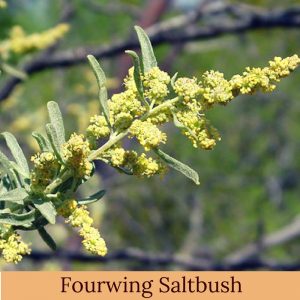
Fourwing Saltbush (Atriplex canescens)
The evergreen fourwing saltbush grows moderately in full or indirect sunlight. Its dense, rounded form spreads eight feet wide and stands five feet high. Originating from western North America, it has grayish-green leaves and produces green flowers in the spring and summer.

Gray Thorn (Zizyphus obtusifolia v. canescens)
Slow to moderate-growing, the upright form of the deciduous gray thorn shrub measures six feet high and eight feet wide. It prefers full sunlight and is native to Mexico and the southwestern United States. Grayish-green leaves surround creamy flowers in the early summer.

Green Feathery Senna (Senna artemisioides v. filifolia)
This fast-growing evergreen plant calls Australia home and flourishes in full or indirect sun. Standing six feet high and spreading just as wide, the rounded form of the green feathery senna shrub supports medium-green leaves and clusters of yellow flowers from late winter to spring.
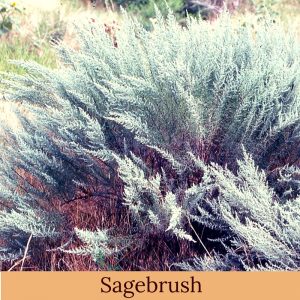
Sagebrush (Artemisia tridentata)
As a perennial shrub standing at two feet high and seven feet wide, the sagebrush has a big trunk with many upward side branches that support the development of flowers in late summer. These tiny yellow or cream-colored blossoms grow in thick clusters along main stems. Wedge-shaped, evergreen leaves measure 1/4 to 2 inches long and have three to five lobes at the tip. Any leaves without lobes will show up in early winter.
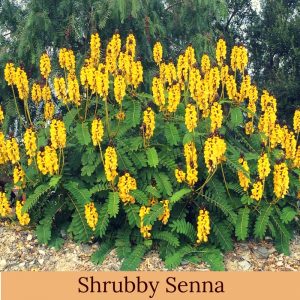
Shrubby Senna (Senna wislizenii)
Native to the Chihuahua Desert, the deciduous shrubby senna develops clusters of bright yellow flowers during the summer. It grows moderately into an upright form with medium-green leaves, standing at four feet high and six feet wide.
![]() Triangleleaf Bursage (Ambrosia deltoidea)
Triangleleaf Bursage (Ambrosia deltoidea)
This plant needs full or indirect sunlight to produce its best silver-green leaves and green flowers from mid-winter to mid-spring. Moderate to fast-growing, the evergreen triangleleaf bursage is native to the Sonora Desert and grows only a foot high and spreads two feet wide.



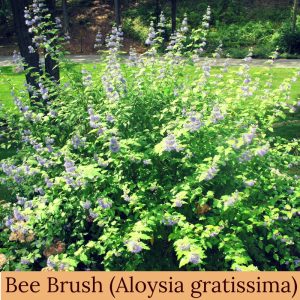 Bee Brush (Aloysia gratissima)
Bee Brush (Aloysia gratissima) Creosote Bush (Larrea tridentata)
Creosote Bush (Larrea tridentata)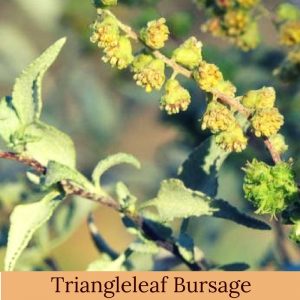 Triangleleaf Bursage (Ambrosia deltoidea)
Triangleleaf Bursage (Ambrosia deltoidea)